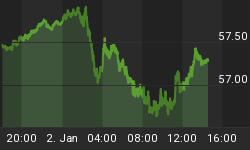The Will Robinson signal is when excessive bullish sentiment occurs at a time of rising inflationary pressures as measured by our composite indicator that assesses the trends in the CRB Index, gold, and yields on the 10 year Treasury. The signal gets it name from the robot (whose name was B-9) on the TV program "Lost In Space", who use to flail his arms and yell "Danger, danger, Will Robinson" when he sensed the young lad was in trouble. Typically, the Will Robinson signal means danger for the stock market.
I have highlighted the Will Robinson signal in the following three articles. The first article was several weeks before the May, 2010 "flash crash". The signal also cropped up in November, 2010 just prior to the implementation of QE2, and we know how that turned out for equities -- they just went higher regardless of the technical or fundamentals.
"Danger, Danger Will Robinson"
The Will Robinson Signal
Excessive Bullish Sentiment Meets Inflationary Pressures
Graphically, the Will Robinson signal is shown in figure 1, a weekly chart of the SP500. The indicator in the lower panel is a composite of our sentiment indicators that we show in our market sentiment wrap up every week. This indicator combines the "dumb money", insider buying and selling, and the Rydex asset data all into a single composite indicator. When the indicator is red that means there are too many bulls (i.e. sell signal) and when the indicator is green that means there are too many bears (i.e., bull signal). Currently the indicator is blue giving us a neutral reading. The red dots over the price bars are the Will Robinson signals, and these are the times where investor sentiment is extremely bullish (i.e., bear signal) and when the indicator constructed from the trends in the CRB Index, gold, and yields on the 10 year Treasury is extreme suggesting high inflationary pressures.
Figure 1. SP500 weekly/ Will Robinson Signals
Figure 2 shows the sentiment indicator and Will Robinson signals from 2004 to 2008.
Figure 2. SP500 weekly/ Will Robinson Signals
Here is the point. There have been 7 Will Robinson signals since 2004, and this includes the most recent signal from November, 2010. In the prior 6 signals, the market essentially topped out (at least on an intermediate term basis), and the next best time to buy the market was when sentiment turned bearish (i.e., bull signal). In other words, the Will Robinson signal always was always followed by bearish sentiment, which is a buy signal.
Turning to the Will Robinson signal from November, 2010, we note that the market not only went higher but sentiment has yet to turn bearish (i.e., bull signal) following the Will Robinson signal. No doubt the POMO and QE 2 have investors buying regardless of the fundamentals or technicals. That being said, the recent correction --if you can call it that -- did correct the excesses from November, 2010, but the next great buying opportunity (bearish sentiment = bull signal) has not materialized.
My reading of all this is: 1) investors continue to put faith -rightly or wrongly - in Fed policies; 2) the inability of the market to sell off to such a degree that investors actually turned bearish suggests to me that the upside to the current rally is limited; 3) the best market bottoms occur when investors are bearish; 4) as the prior 6 Will Robinson signals were followed by extremes in bearish sentiment, it is my expectation that this time will be no different. However, the "fly in the ointment" to such analysis remains the effects of QE2 on the markets.
















